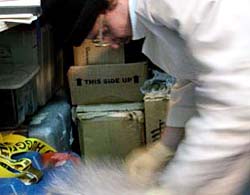|
|
 |
Daily Update
Calendar
Dispatch 24 - August 7, 2002
By C.A. Linder
Weather conditions: : intermittent rain, overcast skies, calm winds and seas, air temperature 35° F.
The Last Cast
A cold, sleety rain fell this afternoon as I photographed the last CTD cast of the cruise. The leaden clouds haven’t parted for the past three days, and the ice seems less mysterious now in this flat light. Some of the larger floes, stained brown from sediments and algae, resemble the melting snow piles you see in parking lots at the end of winter. The lapping waves carve into the larger chunks at the waterline, creating interesting mushroom-like shapes.
 |
|
The ice comes in many shapes and sizes. |
Thankfully, though, the ice has remained thin enough to safely complete this CTD section across the mouth of Barrow Canyon (see Dispatch 23 for map). Spirits were high among both the science party and the crew, because after the CTD was brought back aboard, we turned south and began our transit out of the ice.
 |
 |
|
Sarah Zimmermann works on cleaning up the CTD data. |
|
Click to enlarge |
 |
|
Aaron Morello carefully packs his glassware for the potentially rough transit through the Bering Sea. |
|
Click to enlarge |
Although we have finished collecting our data, there is still a lot of work for the science party! Instruments and computers need to be safely stored for the potentially rough ride through the Bering Sea. We have also now begun in earnest to process our hard-earned data. Unfortunately, as CTD guru Sarah Zimmermann will tell you, this process is far from easy. First, she needs to get rid of obviously erroneous data points. So how can you tell the “good” from the “bad”? The last thing we want to do is throw perfectly good data in the trash just because it seems unusual! Luckily, this problem is one that applies to all kinds of data, and there are a number of mathematical ways to identify these bad data points. Yet, the computer is no substitute for the human brain, and ultimately Sarah has to look at every single cast to make sure they look reasonable. She then runs another program to calibrate the electronic salinity data with the actual salinity content that Jim Schmitt has measured from the water samples. Only then can we look at the CTD profiles and cross-sections and begin to draw conclusions.
I have received a great multi-part question about how the ice affects the oceanography from Jane in Minnesota. If you have any questions about Arctic oceanography or life aboard the Polar Star, send them to arcticedge@whoi.edu.
Q: From what I’ve seen of your spectacular photographs most of the ice flows are in motion - correct? Or are they somewhat stationary?
A: Tom Weingartner answers: The ice is in a continuous state of motion. A general rule of thumb is that the ice is drifting at about 3% of the wind speed. However, during this cruise we have encountered strong currents that are not always flowing in the same direction as the wind. Consequently, the ice will drift in a direction that is due to a combination of both winds and currents.
Q: Is the water just below an ice floe colder as a result of developing ice or warmer from being insulated? Does the sun affect the water temperature at all that far north? Enjoying your writing and photography enormously and can feel your enthusiasm even in Minnesota where we know something about freezing water.... --Jane
A: Tom Weingartner answers: At this time of year, water immediately below an ice floe will be at or close to the freezing point since it is influenced by the recently melted ice. Water distant from the ice floe will be somewhat warmer because the sun has had a chance to warm it up (even if only a few millidegrees!). In the winter, ice does not form in open water until the water column (down to 30-50 meters) cools to the freezing point of seawater (which, depending on the amount of salt present in the water, is about 28° or 29° F).
In the next few days I hope to bring you some more glimpses of our data from the Arctic Ocean and (we are all hoping) photos of the beautiful calm waters of the Bering Sea... Stay tuned!
 Previous Dispatch
Next Dispatch Previous Dispatch
Next Dispatch

Back to Calendar
|
|




